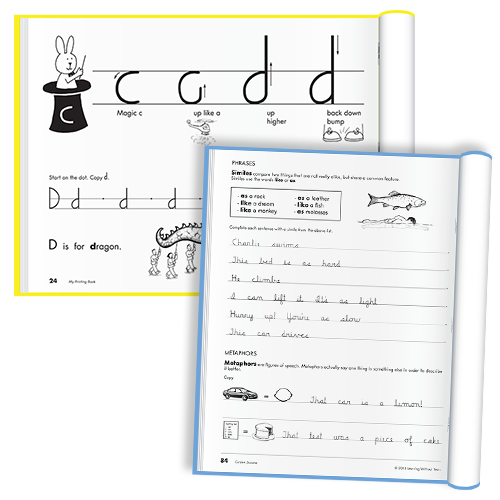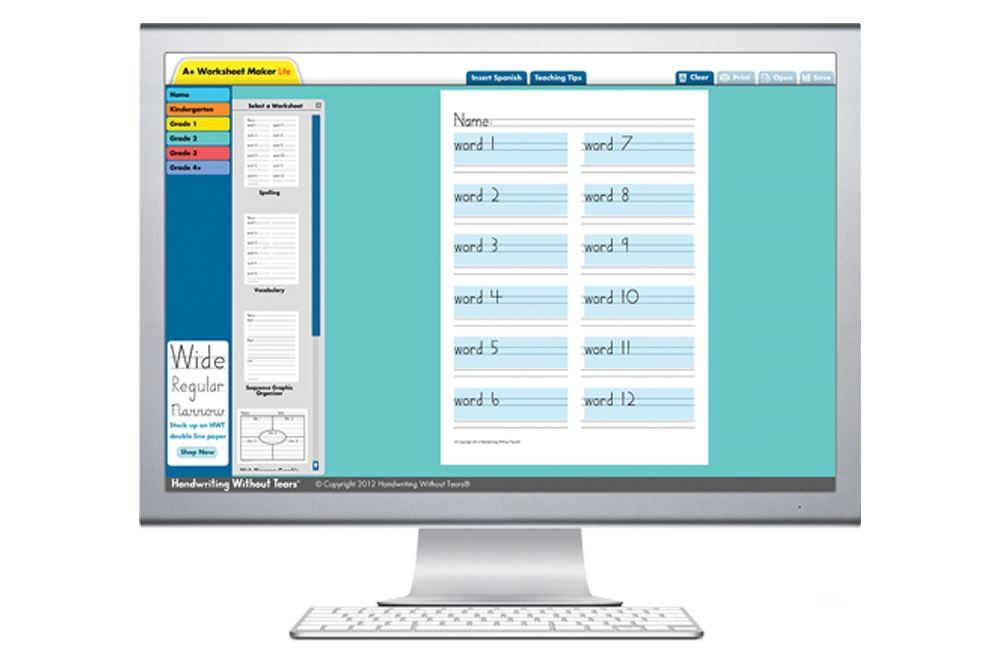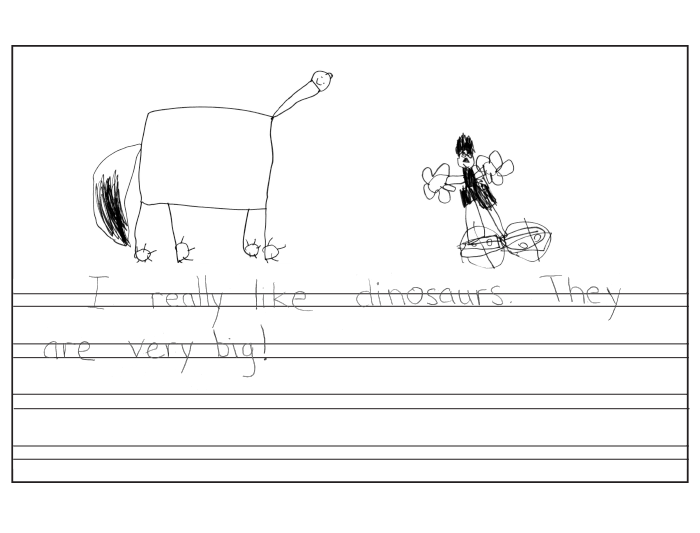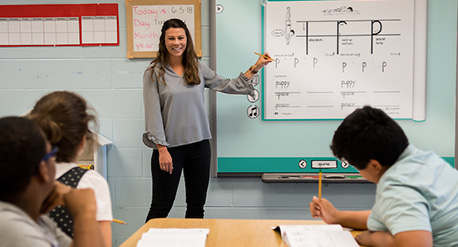If there is one thing educators and administrators have learned so far in 2020, it is that the delivery of education must have flexibility. Both the method of instruction and the means of student participation need to be flexible. What worked when teaching certain content areas last year might not work right now, and the methods you are using right now, might be irrelevant next year.
Two things remain constant:
- Teachers and children must be comfortable accessing and using technology for instruction and learning.
- Children need a way to express their knowledge, thoughts, and ideas.
The way students receive instruction and provide a response requires careful consideration.
Read on to discover why it’s important to include a written component to your lessons, even when students are accessing their assignments digitally.
Technology is King
You know it; we know it: technology is here to stay. Digital instruction, in one form or another, will continue to be a part of education for the indefinite future.
Many subjects and programs are able to be taught 100% digitally, and this has greatly increased the accessibility of education when children cannot physically attend school (hello COVID, I’m looking at you). Many curriculum designers have produced wonderful digital platforms to help teachers present content to students. Other teachers and students have become literal masters this year (whether they wanted to or not!) at using Google Classroom or similar platforms for teaching and for students to complete their assignments.
Technology has allowed education to be more accessible, efficient, and in some cases, more fun! When teaching digital curricula or when teaching virtually, it’s important that you resist one temptation.
Don’t Fall in this Trap!
If you are teaching virtually or in a hybrid setting, or even if you are in a classroom where all students have a device, it is easy to fall in the trap of only requiring typed responses.
If we’re honest, your students probably prefer this (even if they use a hunt and peck method!). It’s convenient for them and usually easier for you to receive, review, and respond to their documents.
Why is this so bad, you might think, as we need to prepare our students for their future, and technology will undoubtedly be a big part of their future education and employment. We agree, and that is why Keyboarding Without Tears was created! It’s a developmental approach to teaching grade-appropriate keyboarding and digital citizenship skills for students in a fun way, and it works!
We know students need to develop correct, quick, efficient keyboarding skills and confidence with navigating technology. However, we can’t brush aside the skill of handwriting just for convenience and under the half-truth that keyboarding is what will best prepare children for their future. Why not? Well, it has to do with their brain.
Children Have the Right to Write
Handwriting has an important role in brain development and in helping children produce higher quality compositions. Writing by hand has been shown to boost brainpower, aid in memory, improve motor skills, and provide a gateway to reading (McFarland 2015). That research might help you buy into the need for handwriting instruction and hand-written assignments in the early grades, but handwriting instruction and practice is not only important for young students.
Older students who took notes by hand versus on a computer were shown to have better comprehension of what was being said and had more sustained attention during discussion of text and concepts (Mueller 2014, Peverly 2012). In other words, being able to write quickly by hand to take lecture notes = less studying time. What student doesn’t want that? Other studies showed that handwriting contributes directly to compositional fluency and quality for beginning and developing writers, and automatic letter writing is the single best predictor of length and quality of written composition (Graham et al., 1997; Graham et al., 2000).

If we don’t give children good instruction in handwriting and frequent opportunity to practice and develop efficient skills, they will have a poor chance of moving beyond the mechanics of writing. Know any students who are really bright, but they don’t look so bright when you look at their written work? Those are the ones who are stuck in the mechanics. Their brains are so bogged down with the mechanics of forming the letters and all the other physical aspects like line placement, sizing, and spacing, that they can’t focus on the content of what they want to write! It’s painful for them, both figuratively and sometimes literally.
When we give students the opportunity to develop fluent handwriting skills, it unlocks their potential in all academic content areas. They can put their thoughts on paper with automaticity in any setting at any time, no matter whether an electronic device is handy or not. It is truly a gift that lasts the rest of their life!
So, to sum up, handwriting is an important life skill that benefits students! Handwriting instruction should be a daily part of elementary education, but it’s not just during handwriting lessons that students should be writing by hand. Handwriting builds a solid foundation for success in all subjects.
Workbooks, Worksheets, and Notebook Paper, Oh My!
Are these elements of students’ nightmares? They don’t have to be, especially if used as a regular part of students’ daily school routine. And they are necessary for building written communication success. Make these a part of all subject areas:
Workbooks: Many school textbooks come with a partnering workbook, or have areas set aside for student response within the book. Use them! Require students to regularly put their pencils to work in those workbooks to demonstrate their knowledge and skills of science, grammar, and math. Explore the Handwriting Without Tears student editions here.

Worksheets: Worksheets have been a classic component of school instruction for decades. Use a critical eye when choosing which worksheets to assign. Consider the size of the font children need to copy or imitate. Does it model the size children need to write and demonstrate appropriate spacing between words? Is there enough room on the response line so that children do not need to cram their words together? Is the worksheet friendly for left-handed students? If not, create your own! Learning Without Tears has a free worksheet design tool called A+ Worksheet Maker Lite that makes it easy for you to create and print spelling, vocabulary, sentence, or graphic organizer worksheets.

Notebook Paper and Journals: Notebook paper and journals are essential for children to develop handwriting fluency. Include writing assignments on blank, lined paper once your students have a good foundation of letter formation and when they understand the components of a good sentence (capitalization, spacing, punctuation). Make sure the lines students are using are appropriate for their grade and skill level. The Learning Without Tears Double-Line Notebook Paper and Journals comes in three different widths to accommodate the size children naturally write in their grade. If you haven’t yet used double-line paper, give it a try! Once they are shown how the double lines work, you will be surprised how much more effectively children are able to write letters in the correct size, which increases overall legibility.

What about Children Who Are Learning From Home?
If you are teaching virtually, you will need a way to demonstrate how you want your students to complete their lessons and review their written work. You can use your cell phone or a web camera on a small tripod (get an inexpensive phone mount attachment for your tripod if you plan to use your phone) to model a few parts of the assigned worksheet or workbook page to help students get started. Then request pictures of completed pages. They can have a parent take a picture with a phone and upload it to your virtual classroom platform, or students can use their device webcam to take a picture of their page to upload.
An Ideal Balance Between Digital and Print Instruction
When evaluating a curriculum to use with students, or when planning how to use the programs you are already using, consider the points raised by this post. How can you provide a balance of digital instruction and participation while also engaging students with thoughtful writing practice through a print component?
Some curriculums make this easy. Learning Without Tears is an industry leader in providing effective handwriting instruction with lessons that take no more than 10 minutes per day. With their added digital teaching component, Handwriting Without Tears is now a great example of how a curriculum can blend digital and print lessons in a way that is effective, engaging, easy to teach, and easy to learn.
The Handwriting Without Tears Digital Teaching Tool allows you to show fun animations, letter formation demonstrations, music, instructive teaching videos, and so much more. A physical workbook, however, is essential for learning handwriting skills. While students are writing in their personal workbook, you can use the workbook feature of the Digital Teaching Tool to display that same workbook page on their device screen, if teaching virtually, or on your classroom whiteboard, if teaching in a classroom. This makes teaching and demonstrating the lesson simple for you and helps your students know what to do!

The Goal: Written Production Success in ALL Content Areas!
Written production skills are essential for academic success. Whether students are learning from home or in the classroom, and whether you are teaching with a digital curriculum or a textbook, you can help your students develop the skills they need by teaching foundational handwriting and keyboarding skills and then requiring them to use those skills in their daily lessons. Yes, digital lessons are not going anywhere anytime soon. But it’s our responsibility as educators to ensure students have the skills they need for future academic and employment success, and that includes the life skill of writing by hand and keyboarding. Use those wonderful digital platforms and lessons, AND use a printed component as well. That’s a recipe for academic success!
To learn more about how Learning Without Tears combines digital and print lessons, click here.
Sources
- HWT Efficacy Research
- Berninger, V. W., Vaughan, K. B., Abbott, R. D., Abbott, S. P., Rogan, L. W., Brooks, A., Reed, E., & Graham, S. (1997). Treatment of handwriting problems in beginning writers: Transfer from handwriting to composition. Journal of Educational Psychology, 89(4), 652–666. https://doi.org/10.1037/0022-0663.89.4.652
- Graham, S., Harris, K. R., & Fink, B. (2000). Is handwriting causally related to learning to write? Treatment of handwriting problems in beginning writers. Journal of Educational Psychology, 92(4), 620–633. https://doi.org/10.1037/0022-0663.92.4.620
- Saperstein Associates. 2012. “Handwriting in the 21st Century? Research Shows Why Handwriting Belongs in Today’s Classroom: A Summary of Research Presented at Handwriting in the 21st Century? An Educational Summit.” http://sapersteinassociates.com/data/2_29_HW_Summit_White_Paper_eVersion.pdf
- Mueller, Pam A., Daniel Oppenheimer. 2014. “The Pen Is Mightier Than the Keyboard: Advantages of Longhand Over Laptop Note Taking,” Psychological Science Vol. 25 (6).
- Peverly, Stephen. 2012. “The Relationship of Transcription Speed and Other Cognitive Variables to Note-Taking and Test Performance.” Presented at Handwriting in the 21st Century? An Educational Summit, Washington, DC, January 23.